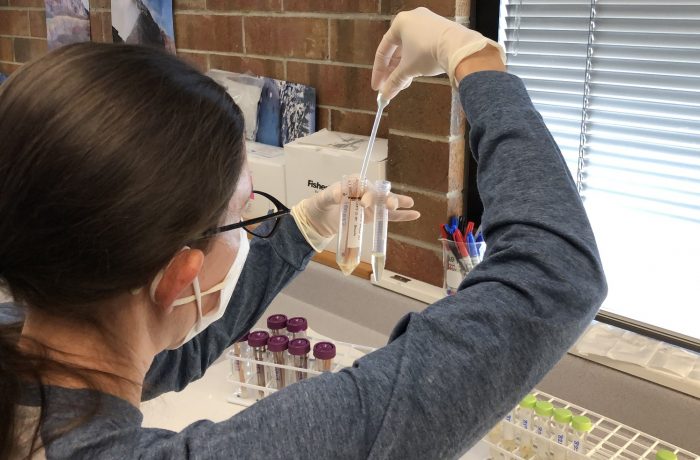An environmental consulting company approached Pisces Molecular in early 2020 with a significant challenge for a lab of our small size: could we adapt or develop de novo eDNA assays for five aquatic species, supply sample collection materials, and test 700 samples in a period of a few weeks? The consulting company’s client was a large-scale infrastructure project that was under pressure to deliver an accurate environmental impact report on a tight deadline and with potential legal ramifications. The Pisces team (at the time, three scientists and one office manager) agreed that we were up to the challenge: as soon as the contract was finalized, work began on the research and development phase of the project in late March 2020, with a deadline to deliver the final test results by the third week of April 2020.
As is our standard practice for any new assay that we adapt or develop at Pisces, we asked our client to provide positive control samples (i.e., tissue samples from each of the target species, and eDNA samples from known-positive locations). This extra level of rigor allows us to validate that our assays are performing as expected, and that negative qPCR results can be trusted to be true eDNA-negatives. The five target species in this project were at the time listed as federally endangered or threatened in the United States, and therefore harvesting and transport of their tissues was strictly regulated. Obtaining tissue samples for assay validation was therefore not a simple task, but our client was able to provide us with tiny amounts of tissue from precious museum samples for four of the five target species.
Part of the logistical challenge represented by this project was testing for multiple target species in each of the nearly 700 eDNA filter samples in a short time frame. Not every sample needed to be tested for all five target species; the batch was divided into subsets of samples to be tested for different combinations of them. Running qPCR tests for each species alone in a 96-well format (each sample in triplicate, 87 sample wells + 8 control wells per run), it would have necessitated at least 35 qPCR runs - or in terms of qPCR setup and run time, approximately 80 hours - not including potential repeat testing on outliers or samples at the limit of detection! Pisces’ solution was to multiplex some of these assays together to allow testing for two species in one qPCR run, significantly speeding up the testing phase.
Of the five species we were approached to develop testing for, only one had a published assay that was relatively easy to adapt to Pisces’ systems: a freshwater fish in the perch family called Roanoke Logperch (Percina rex, endangered). The published SYBR Green qPCR assay (Strickland and Roberts, 2019) targets a 121 bp fragment of the mitochondrial cytochrome B (CytB) gene. Pisces modified this assay to include a high-resolution melt (HRM) analysis to improve detection sensitivity. Although no known-positive tissue samples of P. rex were available for us to confirm the accuracy of the published primer sequences in vitro, we did detect P. rex in several of our client’s eDNA samples during the testing phase.
The other four species of concern in this project were freshwater mussels, and included three federally endangered and one federally threatened species: James River Spinymussel (Parvaspina collina, formerly in genus Pleurobema, endangered), Clubshell (Pleurobema clava, endangered), Snuffbox Mussel (Epioblasma triquetra, endangered), and Atlantic Pigtoe (Fusconaia masoni, threatened).
Although a published SYBR Green qPCR assay for P. collina (James River Spinymussel) was available (Roderique, 2018), since SYBR Green dye hybridizes to all double-stranded DNA, we could not use the P. collina assay as-published for multiplexing. Pisces developed a dual-labeled hydrolysis probe (TaqMan) qPCR assay for P. collina targeting a 112 bp fragment of the mitochondrial ND1 gene (NADH-ubiquinone oxidoreductase chain 1, GenBank accession EU414274). This Pisces-developed assay included a novel probe sequence and primers which overlapped with but were not identical to the primers published in Roderique, 2018. We validated this assay by positive qPCR results on known-positive P. collina tissue samples and confirmed its specificity in silico by comparing the primer and probe sequences with several of Pleurobema ND1 sequences from GenBank. This P. collina qPCR assay was then combined with a dual-labeled hydrolysis probe (TaqMan) qPCR assay designed de novo at Pisces targeting a 211 bp fragment of the mitochondrial ND1 gene of F. masoni (Atlantic Pigtoe, GenBank accession MH133774). This allowed us to test for both mussel species at the same time in the same qPCR reaction.
Since no published assays existed at the time for Clubshell and Snuffbox mussels (P. clava and E. triquetra, respectively), Pisces developed the first dual-labeled hydrolysis probe (TaqMan) qPCR assays for both species and combined them into one multiplex qPCR. Our P. clava assay targeted an 81 bp fragment of the mitochondrial ND1 gene (GenBank accession AY613802), and our E. triquetra assay targeted a 143 bp fragment of the mitochondrial ND1 gene (GenBank accession AY094375). Though the typical annealing temperature for a qPCR assay is 60°C, we increased the annealing temperature to 64°C for higher specificity. We confirmed the accuracy of our primer and probe sequences by positive qPCR results on known-positive P. clava and E. triquetra tissue samples, and validated specificity in silico by comparing the primer and probe sequences with a variety of Pleurobema and Epioblasma ND1 sequences in GenBank.
In order to collect nearly 700 eDNA samples in a time-efficient manner, our client needed a large amount of sample collection supplies to distribute to their field teams. Pisces supplied eDNA sample collection materials including over 950 MilliporeSigma™ Swinnex housings loaded with filters (assembled by Pisces staff), and 28 of our Pisces-developed and assembled eDNA collection bottles. Our client’s field teams began sampling in mid-March 2020 and worked as quickly as they could to collect samples and return them to us for testing. The last shipment, completing a set of 692 eDNA and 8 tissue samples, arrived just two weeks before the final results were needed.
In March 2020, what would eventually become the protracted COVID-19 pandemic was just beginning to affect business and daily life across the United States. As infections of SARS-CoV-2, the virus that causes COVID-19, increased dramatically, public health departments across the U.S. began instituting business shutdowns and mask mandates in an effort to ease the burden of COVID-related hospitalizations on healthcare resources. Pisces was deemed an “essential” business that could continue operating in a limited fashion, but we had to adapt to doing business safely in the context of a pandemic lockdown. We rallied as a team under these unusual circumstances to deliver results for our client while also keeping ourselves and each other safe: trading off days in the lab, working weekends, working from home, narrowing our social circles, and wearing face masks at all times in the building. We developed a streamlined workflow for eDNA filters in Swinnex housings that allowed one scientist to efficiently prepare all 700 samples for DNA extraction within a shorter-than-usual timeframe, and for another scientist to follow quickly behind with the DNA extraction step. All DNA extractions were done in a 96-well format using Qiagen DNeasy spin column kits. We also used a Qiagen QiaCube robot to augment the throughput of by-hand extractions.
With our improved workflows, multiplexed qPCR assays, and everyone at Pisces performing at their highest level, we were able to complete all the sample preparation and qPCR testing for this project within a few weeks. We delivered complete results to our client on schedule on April 24, 2020, with enough time for them to complete their own report to their own client.
This was a large-scale, high-stakes project that included research and development work, high sample volume, intense time pressure and the exceptional circumstances of the COVID-19 pandemic. Not only did we complete the project on time, our rigorous systems for sample prep and testing (honed over decades) ensured the accuracy and legal defensibility of the results. The end result of Pisces’ ability to engage with such a project has been a happy client who has since returned to us several times with other new and interesting projects (including bat sex ID from mixed fecal samples – story to come soon)!
References:
Roderique, B.A. 2018. Improving the conservation of a cryptic endangered freshwater mussel (Parvaspina collina) through the use of environmental DNA and species distribution modeling. https://scholarscompass.vcu.edu/etd.
Strickland, G.J. and J.H. Roberts. 2019. Utility of eDNA and occupancy models for monitoring an endangered fish across diverse riverine habitats. Hydrobiologia 826:129–144.

